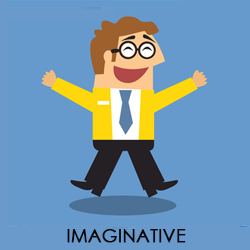The Learner's Brain and Stories
In her 4MAT principle of learner types, Bernice McCarthy categories most learners into four distinct types:
1. Imaginative - Type 1 Learners are very imaginative. They relate to new things through their emotions and reflections. They work with their instinct and gut feeling and process new information based on their own personal scope of experience. They ask, "Why do I need to know this?"

Story-Based Learning Design Tip:
Note: SRIA is a design methodology taught in the Story-Based eLearning Workshops
2. Methodical - Type 2 Learners are methodical and knowledge-based. They like structure and process, hitting all the points and connecting all the dots in proper order. They are systematic and like things to be done the right way. They ask, "What exactly is this?"

Story-Based Learning Design Tip:
In SRIA™, we allow learners to "Apply." Instead of memorizing content, we encourage learners to apply ideas in a real-life situation. "Connecting the dots" means the learners understand the content in their own real-life situations.
3. Problem-solvers - Type 3 Learners are problem solvers. When asked to learn they will look at situations critically, creating their own way towards a solution. They flourish best when left alone to figure things out and feel accomplished when they produce real outcomes. They ask, "How can I use this in my life?"

Story-Based Learning Design Tip:
In SRIA™, one model is problem-solving and troubleshooting using micro-scenarios. Learners are put on the spot and allowed to solve the problems.
4. Creative - Type 4 Learners are dynamic and creative. They learn best outside of routine and planned activities. They need to be on the move constantly, engaging in lively discussion and collaboration. Memorization and standardized testing do not work for these learners. They need to experience things for themselves before anything makes sense. They ask, "What if I do it this way?"

Story-Based Learning Design Tip:
In SRIA™, one of the application ideas is to allow learners to learn by trial and error. With this method, we provide the learners an avenue to get creative and discover options.
The learners in your sessions can be one of these types, or a combination of two or more. Part of the skill of a masterful trainer is to be able to design a program that can affect and engage all four types. It's like planning a party: there has to be something for everybody.
Our brains are wired to respond to stories, and the stories you will use will need to answer the questions asked by each learner type.
The good news is, interactive stories are already set up to do this.
- they appeal to emotions
- make people think
- encourage personal application
- inspire people to try new perspectives
Set-up - Why do I need to know this?
Relate - What exactly is this?
Interpret - What if I do it this way?
Apply - How can I use this in my life?
Reference

To learn more about SRIA™, download the free eBook "Story Impacts Learning and Performance", click here to download.
Ray Jimenez, PhD
Vignettes Learning
"Helping Learners Learn Their Way"

No comments:
Post a Comment
Welcome! Sharing your comments is very valuable learning experience for me and others. Thanks!